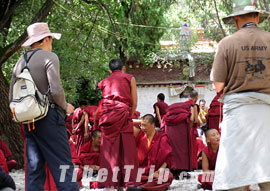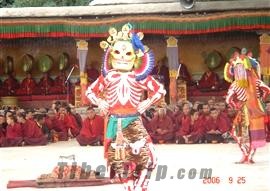 The Daily Life of the Average Monks
The Daily Life of the Average Monks
The life of the average monk in a monastery is very rigorous. Reciting sutras is obligatory for all, it usually twice a day at dawn and dusk. Every time the bell rings in the monastery, all the monks congregate in the Main Assembly Hall. Sometimes they also have to recite before lunch. The morning-reciting is the most important of the three.

After a simple breakfast of Yak Butter Tea and Tsamba, they continue to learn sutras in the morning. Then they usually form groups of two or three to debate in the afternoon. Their lessons start from the basic knowledge of Tibetan and some simple prayers and eulogies, but the study of the extensive sutras is a long haul that takes over ten years to achieve the Buddhist degree. Only those who have passed the highest debate and achieve the highest degree qualify for the Khenpo of a monastery, which may be the biggest honor for a monk. Beside the sutras, Tibetan medicine, calendar, geography, art and other subjects are also added to the lessons to broaden the monks' horizons. Due to a closer contact between monasteries and the outside world, Sanskrit, Chinese, and even English may also be taught.
 Religious Ceremonies
Religious Ceremonies
Religious ceremonies are also common and full of grandeur in the monasteries. Tibetan Festivals are very frequent and very important for the people of Tibet. As a festival approaches, monasteries will mobilize monks to make elaborate preparations for it. Usually dances of deities or animals played by monks with odd dressings are performed. The Great Prayer Festival is celebrated from Jan. 3rd to Jan. 25th of Tibetan Calendar in Lhasa and is the grandest. This included be a great debate among the highest lamas of Lhasa in Jokhang Temple.

 The Special Work of Monks
The Special Work of Monks
Not all the monks have lessons and debate every day. There are some specially trained monks who go out in the public and pray for blessings, release souls of the deceased from purgatory or do some divination for members of the public. The expert artisans amongst the monks also do some paintings, sculptures or medical treatments. Some higher lamas also take charge of the repair and protection work of halls of the temple and other daily affairs.
 The Life of the Nuns
The Life of the Nuns
The monastery life of nuns is very similar to monks', but tougher and quieter. There are much fewer nunneries in Tibet and they are generally much simpler. Their spare time is mainly spent on prayers and reciting the Mantra 'Om Mani Padme Hum' while rotating prayer wheels. Their self-cultivation is conducted through sitting in meditation in their own room and any outside activity or interruption during this time is not allowed. And every month they have several days when eating is forbidden. The only entertainment they have usually is to see the dance performances in the nearby monasteries. However, during the Tibetan New Year they have five free days to fully enjoy themselves by singing, dancing and playing Tibetan Opera.








